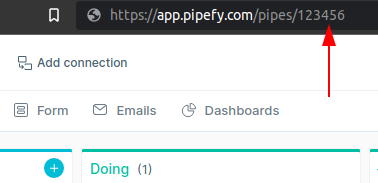Definition
A Pipe represents a process in your company.
Pipefy allows you to set up pipes for almost every process in your company - such as purchase requisitions, customer support, sales, etc.
Hierarchy and Relations
Accessible through: Organizations, Cards
Objects pipes can access directly: Phases, Start Form Fields, Users, Labels
Pipes in our API
Through the GraphQL API, you can retrieve a pipe's information, interact with pipes and execute the actions you're able to do within Pipefy's graphical interface.
As described here, GraphQL operations always use the HTTP POST method, and you can use queries and mutations to interact with the API.
Pipe Queries
Queries are used to fetch data from Pipefy.
Note
The pipe ID can be retrieved on the interface by looking at the URL of the pipe's page.

Where to find a pipe's ID
Queries of how to retrieve a pipe or group of pipes are shown in the code block below. Replace '12345' with the ID of the pipe you'd like to query for. The following fields are the most used, but there are a lot more options of data you can select from Pipes. Remember: GraphQL is a query language, so query whatever you need.
{
pipe(id: 123456) {
id
name
color
users_count
cards_count
opened_cards_count
emailAddress
}
}
{
pipes(ids: [12345, 987654, 654321, 987321]) {
id
uuid
name
cards_count
}
}
{
pipe(id: 123456) {
id
uuid
name
cards_count
organization {
id
}
members{
role_name
user{
id
email
}
}
phases {
id
name
}
start_form_fields {
id
label
}
labels{
id
name
color
}
webhooks {
name
id
}
}
}
Pipe Mutations
Be aware that running a mutation in our playground will change the Data inside Pipefy.
Most of the Pipefy API functionalities allow the CRUD operations. We saw before the Read operations to get pipes, here are the Mutations to Create, Update and Delete. Mutations are used to change data in Pipefy.
The minimum amount of information you need to provide to create a pipe is the name and the organization id, but to update or delete it's necessary to, at least, provide the pipe ID. If you don't know your pipe ID you can use the Organizations queries to list all your pipes and their attributes.
mutation {
createPipe(input: {name: "Pipe name", organization_id: 987654}) {
clientMutationId
}
}
mutation {
updatePipe(input: {id: 789456, name: "New pipe name", public: true, anyone_can_create_card: true, color: green}) {
pipe {
id
}
}
}
mutation {
deletePipe(input: {id: 987654}) {
success
}
}
Testing our API
When querying for pipes, there's much more information available than the ones in the examples above.
Also, keep in mind that our API has a lot of queries and mutations available not only about pipes.
For a full list of our GraphQL capabilities, you can access our GraphQL playground and play around with it.
